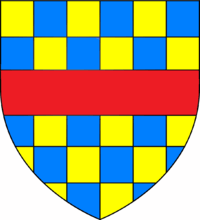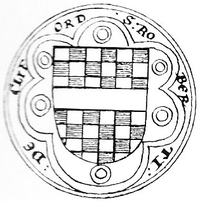Robert de Clifford, 1st Baron de Clifford



Robert de Clifford, 1st Baron de Clifford (c. 1274–1314), of Appleby Castle, Westmorland, feudal baron of Appleby and feudal baron of Skipton in Yorkshire, was an English soldier who became 1st Lord Warden of the Marches, responsible for defending the English border with Scotland.
Origins
He was born in Clifford Castle, Herefordshire, a son of Roger II de Clifford (d.1282) (a grandson of Walter II de Clifford (d.1221), feudal baron of Clifford[1]) by his wife Isabella de Vipont (d.1291), one of the two daughters and co-heiresses of Robert II de Vipont (d.1264), feudal baron of Appleby, grandson of Robert I de Vieuxpont (d.1227/8). Thenceforth the Clifford family quartered the arms of Vipont: Gules, six annulets or.
The ancient Norman family which later took the name de Clifford arrived in England during the Norman Conquest of 1066, and became feudal barons of Clifford, first seated in England at Clifford Castle in Herefordshire. The de Clifford family was directly descended in the male line from Duke Richard I of Normandy (933-996), great-grandfather of William the Conqueror:[2] the father of Walter de Clifford, 1st feudal baron of Clifford (d.1190) was Richard FitzPontz (d. circa 1138), the son of Pontz, the son of William Count of Eu, a son of Richard I of Normandy (933-996) by his wife Gunnor.[3]
Inheritances
As his father had predeceased his own father, in 1286 Robert inherited the estates of his grandfather, Roger I de Clifford (d.1286). Following the death of his mother Isabella de Vipont in 1291 he inherited a one-half moiety of the extensive Vipont feudal baron of Appleby in Westmorland. In 1308 he was granted the remaining moiety by his childless aunt Idonea de Vipont (d.1333)[4] and thus became one of the most powerful barons in England.
Career
During the reigns of Kings Edward I and Edward II, Clifford was a prominent soldier. In 1296 he was sent with Henry de Percy, 1st Baron Percy to quell the Scots who asked for terms of surrender at Irvine. He was appointed Governor of Carlisle. During the reign of Edward I he was styled Warden of the Marches and during the reign of Edward II, as Lord Warden of the Marches, being the first holder of this office.[5] In 1298 he fought for King Edward I at the Battle of Falkirk in which William Wallace was defeated, for which he was rewarded with Governorship of Nottingham Castle. He was summoned to Parliament by writ as a baron in 1299. He won great renown at the Siege of Caerlaverock Castle in 1300, during which his armorials (Chequy or and azure, a fesse gules) were recorded by the heralds on the famous Caerlaverock Roll or Poem, thus (translated from French):[6]
- "Strength from wisdom drawing, Robert Lord de Clifford's mind is bent on his enemies' subjection. Through his mother his descent comes from that renowned Earl Marshal at Constantinople said to have battled with a unicorn and struck the monster dead. All the merits of his grandsire, Roger, still in Robert spring. Of no praise is he unworthy; wiser none was with the King. Honoured was his banner, checky gold and blue, a scarlet fess. Were I maiden, heart and body I would yield to such noblesse!"
He was one of many who sealed the 1301 Barons' Letter to the Pope, in the Latin text of which he is described as Robertus de Clifford, Castellanus de Appelby ("Constable of Appleby Castle").[7] After the death of King Edward I in 1307, he was appointed counsellor to Edward II, together with the Earl of Lincoln, Earl of Warwick and Earl of Pembroke. In the same year of 1307 the new king Edward II appointed him Marshal of England, and in this capacity he probably organised Edward II's coronation on 25 February 1308. On 12 March 1308 he was relieved of the marshalcy, the custodianship of Nottingham Castle and of his Forest justiceship, but on 20 August 1308 he was appointed captain and chief guardian of Scotland.[8] In 1310 Edward II also granted him Skipton Castle and the Honour of Skipton in Yorkshire, held until that date by Henry de Lacy, 3rd Earl of Lincoln (1251-1311).[9] Henry de Lacy had married Margaret Longespée, Robert de Clifford's cousin and heiress of the feudal barony of Clifford, which had descended in a female line from Robert de Clifford's great-great uncle, Walter II de Clifford (d.1263), Margaret Longespée's maternal grandfather.[3]
In 1312 together with the Earl of Lancaster he took part in the movement against Piers Gaveston Edward II's favourite, whom he besieged in Scarborough Castle.
Marriage & progeny
In 1295 in Clifford Castle he married Maud de Clare, eldest daughter of Thomas de Clare, Lord of Thomond by his wife Juliana FitzGerald. By Maud he had three children:[10]
- Roger de Clifford, 2nd Baron de Clifford.
- Robert de Clifford, 3rd Baron de Clifford.
- Idonia de Clifford, wife of Henry de Percy, 2nd Baron Percy.
Death & burial
Clifford was killed on 24 June 1314 fighting at the Battle of Bannockburn[5] and was buried at Shap Abbey in Westmoreland.
References
- ↑ Sanders, pp.35-6, Clifford; Vivian, p.194, Pedigree of Clifford
- ↑ Vivian, Lt.Col. J.L., (Ed.) The Visitations of the County of Devon: Comprising the Heralds' Visitations of 1531, 1564 & 1620, Exeter, 1895, p.194
- 1 2 Vivian, p.194
- ↑ Sanders, I.J. English Baronies: A Study of their Origin and Descent 1086-1327, Oxford, 1960, p.104, Appleby
- 1 2 Notes and Queries, Oxford University Press, 15 March 1862, p. 220
- ↑ http://www.theheraldrysociety.com/articles/early_history_of_heraldry/siege_of_caerlaverock.htm
- ↑ Howard de Walden, Lord, Some Feudal Lords and their Seals 1301, published 1903 reprinted 1984, image of seal p.31
- ↑ Henry Summerson, Robert Clifford, first Lord Clifford, Oxford Online Dictionary of National Biography, 2004
- ↑ Sanders, I.J. English Baronies: A Study of their Origin and Descent 1086-1327, Oxford, 1960, p.143
- ↑
 "Clifford, Robert de". Dictionary of National Biography. London: Smith, Elder & Co. 1885–1900.
"Clifford, Robert de". Dictionary of National Biography. London: Smith, Elder & Co. 1885–1900.
-
 This article incorporates text from a publication now in the public domain: Chisholm, Hugh, ed. (1911). "article name needed". Encyclopædia Britannica (11th ed.). Cambridge University Press.
This article incorporates text from a publication now in the public domain: Chisholm, Hugh, ed. (1911). "article name needed". Encyclopædia Britannica (11th ed.). Cambridge University Press.
| Peerage of England | ||
|---|---|---|
| Preceded by New Creation |
Baron de Clifford 1299–1314 |
Succeeded by Roger de Clifford |
| Political offices | ||
| Preceded by Roger Bigod |
Lord Marshal 1307-1308 |
Succeeded by Nicholas Seagrave |